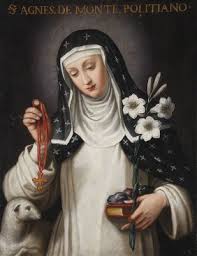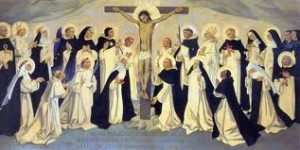Saint of the Day
Summary: Saint Agnes is sometimes represented with a model of her home town of Montepulciano in her hand and is still revered there and throughout Tuscany. She had a reputation as a miracle worker.
Patrick Duffy outlines her life.
Montepulciano
 Agnes was born into a noble family in Gracciano, a small village near Montepulciano in Tuscany, Italy, where, at the age of nine, she entered the local convent. When in 1281 a new foundation was made at Proceno, Agnes went there and later became the superior. Later again the citizens of Montepulciano invited her to return and she set up a convent under the Dominican order in the town in houses that had been used as brothels. The convent prospered under her direction.
Agnes was born into a noble family in Gracciano, a small village near Montepulciano in Tuscany, Italy, where, at the age of nine, she entered the local convent. When in 1281 a new foundation was made at Proceno, Agnes went there and later became the superior. Later again the citizens of Montepulciano invited her to return and she set up a convent under the Dominican order in the town in houses that had been used as brothels. The convent prospered under her direction.
Reputation for Miracles
Agnes had a reputation for prophecies and miracles: curing people suffering from physical and mental sickness, multiplying loaves as Jesus did, and so on. She seems to have been a no-nonsense, energetic woman.
Her Death
In her forties Agnes suffered a long and painful illness and the sisters persuaded her to take the waters of the local spa. When her health did not improve she said to the sisters: “If you loved me, you would be glad that I am about to enter the glory of my spouse. Do not grieve over my departure: I shall not lose sight of you. You will find I have not abandoned you and you will possess me forever.” She died aged forty-nine.
Still Revered in Tuscany
Agnes’s tomb was much visited by pilgrims including the Emperor Charles IV and St Catherine of Siena. In art she is sometimes represented with a model of her town in her hand. She is still greatly revered in Tuscany.






















